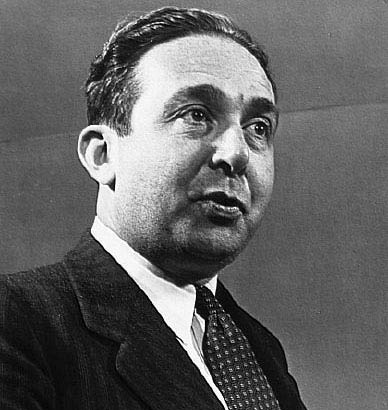
Leo Szilard
(1898 - 1964)
Leó Szilárd (February 11, 1898 – May 30, 1964) was a Jewish Hungarian-American physicist who worked on the Manhattan Project. He was born in Budapest and died in La Jolla, California.
Personality
Szilard was well known to his colleagues as an eccentric, lightning-quick thinker who "seemed fond of startling people" with strange, seemingly incongruous, yet extremely perceptive statements and questions. He was also extremely good at predicting political events. He is said to have predicted World War I as a boy, and when the Nazi party first appeared, he predicted that it would one day control Europe. In 1934, he foresaw the details of World War II. He then made a habit of residing only in hotel rooms, with a packed suitcase always on hand.
Developing the idea of the nuclear chain reaction
In 1933 Szilard fled to London to escape Nazi persecution, where he read an article written by Ernest Rutherford in The Times which rejected the concept of atomic energy. Although nuclear fission had not yet been discovered, Szilard was reportedly so annoyed at this dismissal that he conceived of the idea of the nuclear chain reaction while waiting for traffic lights to change on Southampton Row in Bloomsbury. The following year he filed for a patent on the concept.
Szilard first attempted to create a chain reaction using beryllium and indium, but these elements did not produce a chain reaction. In 1936, he assigned the chain-reaction patent to the British Admiralty to ensure its secrecy (UK Patent 630726). Szilárd also was the co-holder, with Nobel Laureate Enrico Fermi, of the patent on the nuclear reactor (U.S. Patent 2708656).
In 1938 Szilard accepted an offer to conduct research at Columbia University in Manhattan, and moved to New York, and was soon joined by Fermi. After learning about nuclear fission in 1939, they concluded that uranium would be the element capable of sustaining a chain reaction.
The Manhattan Project
Szilárd was instrumental in the development of the Manhattan Project. It was his idea to send a confidential letter to Franklin D. Roosevelt explaining the possibility of nuclear weapons, and to encourage the development of a program which could lead to their creation. In August 1939 he obtained Albert Einstein's endorsement of this proposal, and the Einstein-Szilárd letter eventually led to the establishment of research into nuclear fission by the U.S. government. Later, he moved to the University of Chicago to continue work on the project. There, along with Fermi, he helped to construct the first "neutronic reactor", a uranium and graphite "pile" in which the first self-sustaining nuclear chain reaction was achieved, in 1942.
As the war continued, Szilárd became increasingly dismayed that he was losing control over his scientific developments to the military, and clashed many times with General Leslie Groves, military head of the project. His resentment towards the U.S. government was exacerbated by his failed attempt to avoid the use of the atomic bomb in war.
Szilárd became a naturalized citizen of the United States in 1943.
Views on the use of nuclear weapons
Szilard was probably the first scientist to seriously examine the science behind the creation of nuclear weapons, as he knew about the fictional "atomic bombs" described in H. G. Wells's science fiction novel The World Set Free. The basic idea of creating an explosive device by harnessing the release of energy from a nuclear chain reaction came to him in a flash of intuition in London on September 12, 1933. He reportedly developed the idea in response to Ernest Rutherford's dismissal of the possibility of obtaining energy from atoms as "moonshine". As a survivor of a devastated Hungary after World War I, and having witnessed the subsequent terror of the Reds and the Whites, Szilárd developed an enduring passion for the preservation of human life and freedom, especially freedom to communicate ideas.
He hoped that the U.S. government, which prior to World War II was staunchly opposed to the bombing of civilians, would not use nuclear weapons, because of their potential for use against civilian populations. Szilárd hoped that the mere threat of such weapons would force Germany and/or Japan to surrender. He drafted the Szilárd petition advocating demonstration of the atomic bomb. However, rather than threatening the Axis Powers, President Harry Truman sided with advisors who thought use of the weapons was the best solution, and chose to deploy the weapons over the protestations of Szilárd and many of the other top scientists in the project. (See also: Atomic bombings of Hiroshima and Nagasaki)
The first atomic bomb blasts resulted in the deaths of as many as 300,000 Japanese civilians, the total destruction of Hiroshima, the partial destruction of Nagasaki, and led within days to the unconditional surrender of Imperial Japan. This was consistent with America's intentional mass bombing of civilian targets in Europe, most notably the firebombing of Dresden and various other German cities, causing more deaths than even Hiroshima and Nagasaki.
Before the war, Szilárd had considered the U.S. the one truly humane government in the world; that is why he chose to assist them, over everyone else, with the atomic bomb. He resigned from this view after the U.S. used the weapons at the conclusion of the war.
After the war
In 1947, Szilard changed fields from physics to molecular biology, working extensively with Aaron Novick. He proposed, in February of 1950, a new kind of nuclear weapon using cobalt as a tamper, a cobalt bomb, which he said might wipe out all life on the planet. He spent his last years as a fellow at the Salk Institute in San Diego. The impact crater Szilárd on the lunar farside is named for him.
Courtesy of:
